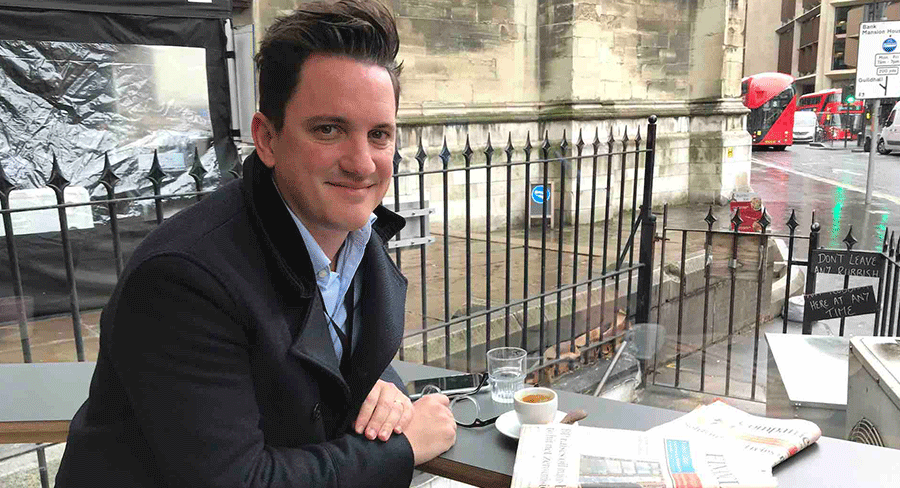The list of Australian journalists working in UK media is long with many expats working both as European correspondents to those who make the move longer-term working for British-based news organisations.
A recent appointment has seen ABC and BuzzFeed Australia alumni Mark Di Stefano take up an important posting at the Financial Times, better known to its readers as The FT.
Di Stefano is perhaps best known locally for his time at BuzzFeed Australia where he arrived six months after launch as its first news hire. He was hired by founding editor Simon Crerar after five years at the ABC. His years at the ABC ran the gamut from copy boy/runner.
“I tried many times to get Fairfax and ABC cadetships. At the ABC I did time on the autocue and I used to work on the 7pm Sydney news for Juanita Phillips. I also did autocue for Jeremy Fernandez on ABC News 24 just after launch. I did time working overnights and I got to present the news on Triple J for about six months,” Di Stefano told Mediaweek in London recently.
Di Stefano then got into TV, working in Darwin for the ABC for 10 months.
His remit at BuzzFeed in 2014? “Simon said just break news.” His title was breaking news reporter. Looking back at those years, he said: “I had no idea what to do. I tweeted a lot and chased the biggest story of the day. For the first year and a half I wrote up any story I could find and then I was appointed political editor.”
Di Stefano joined BuzzFeed in the same year as Daily Mail Australia started and shortly after the launch of Guardian Australia at a time of much activity in the digital news space. “There was an ascendency then of digital media that threatened the long-term future of many legacy publications.”
Facebook then made changes to its news feed algorithm which impacted online publishers. Some were also operating on a business model that hadn’t been proven.
“BuzzFeed was breaking some big stories, but then other publishers like Daily Mail, Nine, Fairfax would replicate what we were doing. BuzzFeed tried a lot of innovation in how we presented the news. Some of it was great, and some of it was bad.”
A move to the UK followed when Di Stefano’s wife managed to convince him to relocate after she had the opportunity to work in London. “I told her I would give it two years. I subsequently applied for the BuzzFeed UK media job and I started working with Janine Gibson, who I now work with at The FT. She took me under her wing and taught me how to be a media reporter. I networked as much as I could taking people out for coffees and drinks. I realised the way to be a reporter in 2020 hasn’t changed that much – it’s all about who you know, having mobile phone numbers and being able to call and text message sources. Old school reporting techniques make for the best stories.”
His time at BuzzFeed UK included the now infamous Waitrose story.
See also:
This Vegan Journalist Pitched To Waitrose Food Magazine, And The Editor Replied Proposing A Series About Killing Vegans
In 2019 The FT offered Di Stefano the role of media and tech reporter. “To me it was a dream job at a newspaper that I completely admire with amazing reporters. It was a compliment that after just two years in the UK I could be trusted to report for The FT.”
The demands of the job at BuzzFeed and The FT are quite different. “I spent my first four weeks there sitting in workshops learning The FT style. It is about communicating what can be incredibly complex things very simply and very clearly. It could be about explaining what is a specialist topic for someone who works in finance and then translate it for someone who comes from a different industry.
“BuzzFeed is much more conversational where you can sometimes here the writers talking to you. At BuzzFeed it was about how can I tell you the news in a way it would work if I was talking to you in a loud pub.
“That is changing now and the quality of reporting at BuzzFeed news I would put up against any other news outlet in the world. The people who now work at BuzzFeed Australia – Gina Rushton, Hannah Ryan and Cam Wilson – can compare with anyone at Nine or News Corp. Other companies will sometimes go and rewrite their reporting and it is a real compliment to the quality of the work at BuzzFeed.
“Some still say they thought BuzzFeed was all cats and gifs, but the perception is changing. The challenge of every media organisation is to find new audiences and get people’s trust.”
When a news organisation hires Mark Di Stefano they are also getting a marketing machine as well. He works hard to promote both the brand and its journalism – his own and that of his colleagues. “Part of that is my Twitter addiction.
“From when I wake up to when I go to bed I am looking at my phone. Twitter is a place where I can get information and ideas. Naturally I am going to tweet. There have been times in the past when I have tweeted something and my boss has called me and questioned whether it was a good look for us. Then I might go and delete that tweet!
“Now in 2020 journalists are expected to promote their work and their employer as an extension of their job. But these days you need to ask how every tweet reflects on you as a journalist and how it signals to the rest of the internet the stuff you are interested in and the type of person you are.”
As to the perception that Twitter has become a cesspit of negativity where trolls roam out of control, Di Stefano said: “There is bad shit everywhere. In the early years of the platform, Australian Twitter was a really great place. It was dominated by people like Mark Colvin, Annabel Crabb, George Megalogenis. It was about sharing links and telling people what was good to read.”
Di Stefano recalled how he nearly got fired from the ABC early in his career there over something he tweeted. “I was transcribing and saw the name of a Canberra media adviser with the same name as a European footballer. I tweeted about the shared name and subsequently got a call from the then bureau chief telling me to take down the tweet. I subsequently received an official warning for something that was just a joke. That is a good example for young journalists that you need to be really careful and that your employer and people who will possibly be your sources could always be watching.
“These days Twitter is much more confrontational, and people are losing their minds on a daily basis. The disappointing thing is that people have lost all notion of proportionality. Small infractions can be blown up into the biggest issues. There is a great quote: ‘Every day there is a main character on Twitter and it is your goal not to be it.’ There can always be a series of fights underway on Twitter and they create tweets that go viral and are turned into new stories that grow from there. Those cycles can then last from one to four days and up to a week.
“You don’t really change anyone’s mind on Twitter. The only reason that you would fight is because you are having fun or you don’t care about the result.”
“What I get from Twitter is conversations that lead me to make enquiries. Any journalist who isn’t addicted to Twitter I would like to shake their hand and ask them to tell me their secret. I would not have got to where I am – in the 10 years from first joining the ABC – without Twitter.”

Working at The FT is a good place to be, said Di Stefano, who is enjoying an independent news brand in a market where competitors are sometimes linked to particular agendas.
The business if owned by Japanese media group Nikkei. “Unlike some newspapers in Australia, The FT doesn’t have preoccupations that can dominate its news coverage. Because it has a paywall, and a dedicated audience paying a fee for the news, it liberates you from having to cover everything. You are always thinking about the stories the audience wants and is happy to pay for.
“Paywalls don’t work for everyone, but they work for The FT.”
As to his future plans, Di Stefano is very happy where he is. His Twitter addiction though needs to some work. “It impacts my relationship in an acute way. My wife can be talking to me while I am scrolling through Twitter. She might stop and I won’t notice. I am concerned about my consumption of news might be impacting my mental health because I am a very anxious person.
“However I understand that things should be consumed in proportion. If I spend 30 minutes on Twitter, then putting it away to have dinner will probably be the most important 30 minutes I will spend that day.”
—
Top Photo: Mark Di Stefano in London in February
